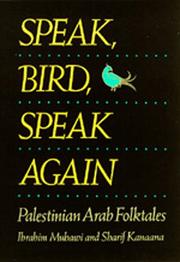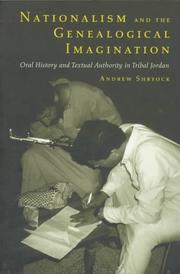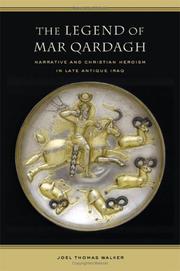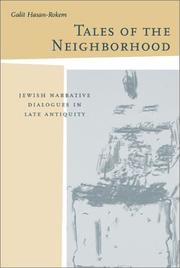| Listing 1 - 10 of 10 |
Sort by
|
Book
Year: 2014 Publisher: Publicacions Universitat Rovira i Virgili
Abstract | Keywords | Export | Availability | Bookmark
 Loading...
Loading...Choose an application
- Reference Manager
- EndNote
- RefWorks (Direct export to RefWorks)
This volume contains a selection of three translations of articles by Josep M. Pujol (Barcelona, 1947–2012), one in each of the three areas that he defined to characterise his work in the field of folklore: the theory of interactive artistic communication; the history of folklore studies and folk literature; and folk narrative. The three articles give a taste of the important contributions he made to the study of folklore, and which have been studied and contextualised by Carme Oriol in the introduction that precedes the three texts. This edition also includes the complete folkloric bibliography of Josep M. Pujol in chronological order, with all the references.
folk narrative --- folklore --- folk literature --- folk narrative --- folklore --- folk literature
Book
Year: 2014 Publisher: Publicacions Universitat Rovira i Virgili
Abstract | Keywords | Export | Availability | Bookmark
 Loading...
Loading...Choose an application
- Reference Manager
- EndNote
- RefWorks (Direct export to RefWorks)
This volume contains a selection of three translations of articles by Josep M. Pujol (Barcelona, 1947–2012), one in each of the three areas that he defined to characterise his work in the field of folklore: the theory of interactive artistic communication; the history of folklore studies and folk literature; and folk narrative. The three articles give a taste of the important contributions he made to the study of folklore, and which have been studied and contextualised by Carme Oriol in the introduction that precedes the three texts. This edition also includes the complete folkloric bibliography of Josep M. Pujol in chronological order, with all the references.
folk narrative --- folklore --- folk literature
Book
Year: 2014 Publisher: Publicacions Universitat Rovira i Virgili
Abstract | Keywords | Export | Availability | Bookmark
 Loading...
Loading...Choose an application
- Reference Manager
- EndNote
- RefWorks (Direct export to RefWorks)
This volume contains a selection of three translations of articles by Josep M. Pujol (Barcelona, 1947–2012), one in each of the three areas that he defined to characterise his work in the field of folklore: the theory of interactive artistic communication; the history of folklore studies and folk literature; and folk narrative. The three articles give a taste of the important contributions he made to the study of folklore, and which have been studied and contextualised by Carme Oriol in the introduction that precedes the three texts. This edition also includes the complete folkloric bibliography of Josep M. Pujol in chronological order, with all the references.
folk narrative --- folklore --- folk literature
Book
ISBN: 0520974662 9780520974661 9780520309586 0520309588 Year: 2019 Publisher: Oakland, California
Abstract | Keywords | Export | Availability | Bookmark
 Loading...
Loading...Choose an application
- Reference Manager
- EndNote
- RefWorks (Direct export to RefWorks)
The four stories that make up the Mabinogi, along with three additional tales from the same tradition, form this collection and compose the core of the ancient Welsh mythological cycle. Included are only those stories that have remained unadulterated by the influence of the French Arthurian romances, providing a rare, authentic selection of the finest works in medieval Celtic literature. This landmark edition translated by Patrick K. Ford is a literary achievement of the highest order.
Welsh literature. --- annwfn. --- arthurian romances. --- bendigeidfran. --- branwen. --- celtic literature. --- celtic mythology. --- celtic. --- celts. --- culhwch and olwen. --- culhwch. --- elphin. --- fiction. --- folk narrative. --- folklore. --- folktale. --- gwion bach. --- gwion. --- gwydion. --- indigenous culture. --- indigenous peoples. --- legend. --- lludd and lleuelys. --- llyr. --- mabinogi. --- manawydan. --- math. --- mathonwy. --- medieval. --- myth. --- narrative. --- prince of dyfed. --- pwyll. --- red book of hergest. --- storytelling. --- taliesin. --- wales. --- welsh mythology. --- welsh tradition. --- white book of rhydderch.
Book
ISBN: 1283277468 9786613277466 0520948173 9780520948174 9781283277464 9780520266360 0520266366 6613277460 Year: 2010 Publisher: Berkeley University of California Press
Abstract | Keywords | Export | Availability | Bookmark
 Loading...
Loading...Choose an application
- Reference Manager
- EndNote
- RefWorks (Direct export to RefWorks)
Scholars have long recognized the relevance to Christianity of the many stories surrounding the life of Alexander the Great, who claimed to be the son of Zeus. But until now, no comprehensive effort has been made to connect the mythic life and career of Alexander to the stories about Jesus and to the earliest theology of the nascent Christian churches. Ory Amitay delves into a wide range of primary texts in Greek, Latin, and Hebrew to trace Alexander as a mythological figure, from his relationship to his ancestor and rival, Herakles, to the idea of his divinity as the son of a god. In compelling detail, Amitay illuminates both Alexander's links to Herakles and to two important and enduring ideas: that of divine sonship and that of reconciliation among peoples.
Christianity. --- Church history. --- Generals --- Alexander, --- Jesus Christ. --- Influence. --- Greece --- History --- Kings and rulers --- alexander the great. --- amazonian queen. --- ancient greece. --- ancient history. --- ancient world. --- campaign. --- christian churches. --- christianity. --- conquest. --- demigod. --- divine son. --- divinity. --- early church. --- empire. --- folk narrative. --- folklore. --- generals. --- greece. --- greek gods. --- hellenism. --- herakles. --- history. --- india. --- jesus. --- legend. --- levi strauss. --- macedonia. --- military leader. --- monotheism. --- myth. --- nonfiction. --- philosopher king. --- political science. --- reconciliation. --- religion. --- son of zeus. --- spirituality. --- structuralism. --- talmudic alexander. --- zeus.

ISBN: 0520062922 9786612355370 0520908732 1282355376 058513541X 9780520908734 9780585135410 0520058631 9780520058637 9780520062924 Year: 1989 Publisher: Berkeley University of California Press
Abstract | Keywords | Export | Availability | Bookmark
 Loading...
Loading...Choose an application
- Reference Manager
- EndNote
- RefWorks (Direct export to RefWorks)
Were it simply a collection of fascinating, previously unpublished folktales, Speak, Bird, Speak Again: Palestinian Arab Folktales would merit praise and attention because of its cultural rather than political approach to Palestinian studies. But it is much more than this. By combining their respective expertise in English literature and anthropology, Ibrahim Muhawi and Sharif Kanaana bring to these tales an integral method of study that unites a sensitivity to language with a deep appreciation for culture. As native Palestinians, the authors are well-suited to their task. Over the course of several years they collected tales in the regions of the Galilee, Gaza, and the West Bank, determining which were the most widely known and appreciated and selecting the ones that best represented the Palestinian Arab folk narrative tradition. Great care has been taken with the translations to maintain the original flavor, humor, and cultural nuances of tales that are at once earthy and whimsical. The authors have also provided footnotes, an international typology, a comprehensive motif index, and a thorough analytic guide to parallel tales in the larger Arab tradition in folk narrative. Speak, Bird, Speak Again is an essential guide to Palestinian culture and a must for those who want to deepen their understanding of a troubled, enduring people.
Folk literature, Arabic. --- Folk literature, Arabic - Palestine - Translations into English. --- Folklore. --- Palestine. --- Palestinian Arabs. --- Palestinian Arabs - Folklore. --- Tales. --- Tales-- Palestine. --- Tales --- Palestinian Arabs --- Folk literature, Arabic --- Folklore --- Anthropology --- Social Sciences --- Arabic folk literature --- Folk tales --- Folktales --- Arabic literature --- Folk literature --- anthropology. --- arab. --- arabs. --- bridegrooms. --- brides. --- courtship. --- creation myths. --- environment. --- fairy tales. --- fiction. --- folk narrative. --- folklore. --- folktales. --- galilee. --- gaza. --- gender. --- husbands and wives. --- islam. --- love. --- middle east literature. --- middle east. --- motif index. --- mythology. --- nature. --- nonfiction. --- oral tradition. --- palestine. --- palestinian arab. --- palestinian culture. --- palestinian folktales. --- palestinian studies. --- parenting. --- romance. --- sexuality. --- social science. --- storytelling. --- typology. --- west bank.

ISBN: 1281125504 9786611125509 0226167283 9780226167282 9780226167268 0226167267 9780226167275 0226167275 9781281125507 Year: 2003 Publisher: Chicago (Ill.): University of Chicago press
Abstract | Keywords | Export | Availability | Bookmark
 Loading...
Loading...Choose an application
- Reference Manager
- EndNote
- RefWorks (Direct export to RefWorks)
Signs and Cities is the first book to consider what it means to speak of a postmodern moment in African-American literature. Dubey argues that for African-American studies, postmodernity best names a period, beginning in the early 1970's, marked by acute disenchantment with the promises of urban modernity and of print literacy. Dubey shows how black novelists from the last three decades have reconsidered the modern urban legacy and thus articulated a distinctly African-American strain of postmodernism. She argues that novelists such as Octavia Butler, Samuel Delany, Toni Morrison, Gloria Naylor, Ishmael Reed, Sapphire, and John Edgar Wideman probe the disillusionment of urban modernity through repeated recourse to tropes of the book and scenes of reading and writing. Ultimately, she demonstrates that these writers view the book with profound ambivalence, construing it as an urban medium that cannot recapture the face-to-face communities assumed by oral and folk forms of expression.
American literature --- Postmodernism (Literature) --- African Americans --- City and town life in literature. --- African Americans in literature. --- Afro-Americans in literature --- Negroes in literature --- African American intellectuals --- African American authors --- History and criticism. --- Intellectual life. --- African Americans in literature --- City and town life in literature --- English literature --- Agrarians (Group of writers) --- Intellectual life --- African American authors&delete& --- History and criticism --- Thematology --- anno 1900-1999 --- african-american, literature, black, blackness, race, racism, subjectivity, postmodernism, print literacy, disillusionment, disenchantment, nonfiction, john edgar wideman, sapphire, ishmael reed, gloria naylor, toni morrison, samuel delany, octavia butler, book, reading, writing, oral storytelling, folk narrative, expression, urban, community, voyeurism, spectacle, information age, mediation, american south, heritage, belonging.

ISBN: 0520916387 0585129843 9780520916388 0520201000 9780520201002 0520201019 9780520201019 9780585129846 Year: 1997 Volume: 23 Publisher: Berkeley, Calif. University of California Press
Abstract | Keywords | Export | Availability | Bookmark
 Loading...
Loading...Choose an application
- Reference Manager
- EndNote
- RefWorks (Direct export to RefWorks)
This book explores the transition from oral to written history now taking place in tribal Jordan, a transition that reveals the many ways in which modernity, literate historicity, and national identity are developing in the contemporary Middle East. As traditional Bedouin storytellers and literate historians lead him through a world of hidden documents, contested photographs, and meticulously reconstructed pedigrees, Andrew Shryock describes how he becomes enmeshed in historical debates, ranging from the local to the national level.The world the Bedouin inhabit is rich in oral tradition and historical argument, in subtle reflections on the nature of truth and its relationship to poetics, textuality, and power. Skillfully blending anthropology and history, Shryock discusses the substance of tribal history through the eyes of its creators—those who sustain an older tradition of authoritative oral history and those who have experimented with the first written accounts. His focus throughout is on the development of a "genealogical nationalism" as well as on the tensions that arise between tribe and state.Rich in both personal revelation and cultural implications, this book poses a provocative challenge to traditional assumptions about the way history is written.
Bedouins --- Oral tradition --- Regions & Countries - Asia & the Middle East --- History & Archaeology --- Middle East --- Tradition, Oral --- Oral communication --- Folklore --- Oral history --- Beduins --- Arabs --- Ethnology --- Nomads --- North Africans --- Historiography --- National movements --- Ethnology. Cultural anthropology --- Jordan --- Genealogy. --- Giordania --- Hashemite Kingdom of Jordan --- Hashimite Kingdom of the Jordan --- Jordania --- Jordanien --- Mamlaka al-Urduniya al-Hashemiyah --- Mamlakah al-Urdunīyah al-Hāshimīyah --- Urdun --- Urdunn --- Yarden --- Transjordan --- abbadi clan. --- adwani clan. --- anthropology. --- bedouin storytellers. --- community. --- contemporary middle east. --- folk history. --- folk narrative. --- genealogy. --- historical documents. --- historical memory. --- historical narrative. --- history. --- jordan. --- literacy. --- middle east. --- modernity. --- national identity. --- nationalism. --- nonfiction. --- oral history. --- oral tradition. --- photographs. --- poetics. --- politics. --- textuality. --- tribal history. --- tribal identity. --- tribal jordan. --- village. --- world history. --- written history. --- Historiography.

ISBN: 1282358820 9786612358821 0520932196 159875937X 9780520932197 1423755537 9781423755531 9781598759372 9780520245785 0520245784 9781282358829 6612358823 Year: 2006 Publisher: Berkeley
Abstract | Keywords | Export | Availability | Bookmark
 Loading...
Loading...Choose an application
- Reference Manager
- EndNote
- RefWorks (Direct export to RefWorks)
This pioneering study uses an early seventh-century Christian martyr legend to elucidate the culture and society of late antique Iraq. Translated from Syriac into English here for the first time, the legend of Mar Qardagh introduces a hero of epic proportions whose characteristics confound simple classification. During the several stages of his career, Mar Qaragh hunts like a Persian King, argues like a Greek philosopher, and renounces his Zoroastrian family to live with monks high in the mountains of Iraqi Kurdistan. Drawing on both literary and artistic sources, Joel Walker explores the convergence of these diverse themes in the Christian culture of the Sasanian Empire (224-642). Taking the Qrdagh legend as its foundation, his study guides readers through the rich and complex world of late antique Iraq.
HISTORY / Ancient / General. --- Qardagh, --- Church of the East --- Nestorian Church --- Old East Syrian Church --- Assyrian Church of the East --- Chaldean Catholic Church --- History. --- History --- Iraq. --- Tašʻítā d-Mārí Qardag sāhdā. --- Tashʻita de-Mar Ḳardagh sahda --- Iraq --- Irak --- Rāfidayn, Bilād --- Bilād al-Rāfidayn --- Republic of Iraq --- Jumhuriyah al Iraqiyah --- Church history. --- Tashʻita de-Mar Ḳardagh sahda. --- Qardagh, -- Mar.. --- Tash?ita de-Mar ?ardagh sahda.. --- Nestorian Church -- Iraq -- History.. --- Iraq -- Church history. --- antiquity. --- arabic. --- archaeology. --- byzantium. --- christian martyr. --- christianity. --- cloister. --- conversion. --- devotion. --- epics. --- festival. --- folk narrative. --- folk tradition. --- folklore. --- hagiography. --- hero. --- iraq. --- kurdistan. --- legend. --- mar qardagh. --- martyr cult. --- martyr. --- martyrdom. --- mission. --- monasticism. --- monks. --- myth. --- nestorian church. --- nonfiction. --- persia. --- persian. --- philosophy. --- piety. --- relics. --- religion. --- religious persecution. --- saint. --- sasanian empire. --- spirituality. --- theology. --- zoroastrianism. --- Tashita de-Mar Kardagh sahda.

ISBN: 1282356879 9786612356872 0520928946 1597349305 9780520928947 0585466009 9780585466002 9780520234536 0520234537 9781597349307 9781282356870 6612356871 0520234537 0520234545 9780520234543 Year: 2003 Publisher: Berkeley University of California Press
Abstract | Keywords | Export | Availability | Bookmark
 Loading...
Loading...Choose an application
- Reference Manager
- EndNote
- RefWorks (Direct export to RefWorks)
In this lively and intellectually engaging book, Galit Hasan-Rokem shows that religion is shaped not only in the halls of theological disputation and institutions of divine study, but also in ordinary events of everyday life. Common aspects of human relations offer a major source for the symbols of religious texts and rituals of late antique Judaism as well as its partner in narrative dialogues, early Christianity, Hasan-Rokem argues. Focusing on the "neighborhood" of the Galilee that is the birthplace of many major religious and cultural developments, this book brings to life the riddles, parables, and folktales passed down in Rabbinic stories from the first half of the first millennium of the Common Era.
Folklore in rabbinical literature. --- Women in rabbinical literature. --- Rabbinical literature --- Jewish legends --- Jews --- Hebrews --- Israelites --- Jewish people --- Jewry --- Judaic people --- Judaists --- Ethnology --- Religious adherents --- Semites --- Judaism --- Women in the Talmud --- History and criticism. --- Galilee (Israel) --- Galil (Israel) --- Israel, Northern --- Jalīl (Israel) --- Northern Israel --- Northern Palestine --- Palestine, Northern --- Social life and customs. --- Jews -- Israel -- Galilee -- Folklore.. --- Jewish legends -- History and criticism.. --- Rabbinical literature -- History and criticism.. --- Women in rabbinical literature.. --- Folklore in rabbinical literature.. --- Galilee (Israel) -- Social life and customs. --- amoraic. --- antique judaism. --- aramaic. --- divinity. --- doctrine. --- early christianity. --- femininity. --- feminism. --- feminist theory. --- folk literature. --- folk narrative. --- folk religion. --- folklore. --- folktales. --- galilee. --- gender studies. --- gender. --- jewish culture. --- jewish life. --- jewish literature. --- jewish religion. --- jewish studies. --- jewish women. --- judaica. --- judaism. --- legend. --- nonfiction. --- parables. --- patriarchy. --- proverbs. --- rabbi. --- rabbinic stories. --- religion. --- religious belief. --- religious stories. --- religious texts. --- riddles. --- taubman. --- theology. --- women and religion. --- womens studies.
| Listing 1 - 10 of 10 |
Sort by
|

 Search
Search Feedback
Feedback About UniCat
About UniCat  Help
Help News
News